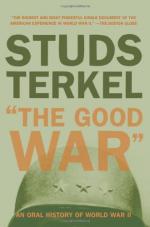
|
1. What are some things that the young men in the war experienced for the first time?
Many young soldiers saw people of other races and nationalities for the first time. They ate unusual foods and saw the beauties of other countries. They became acquainted with boys from their own country who spoke other dialects and lived differently.
2. What did Peter Ota say was different about Japanese-American culture before the war?
According to Peter Ota, the Japanese had been taught that shame was worse than death. Whatever happened, you were to persevere. When ordered into detention camps, they went willingly. Ota believes that they would not go willingly at this state in their maturation and acculturation, and that their children and grandchildren would definitely resist.
3. What stereotypes developed in young people's thinking during the war?
There are many instances of stereotyping among the contributors to this book. Many, looking back on themselves as young people, say they believed that the Japanese were cruel and dishonest, the Germans were a superior race, and the Russians were all fierce warriors. They also believed in themselves as a morally superior group.
(read all 60 Short Essay Questions and Answers)
|
This section contains 3,757 words (approx. 13 pages at 300 words per page) |

|




